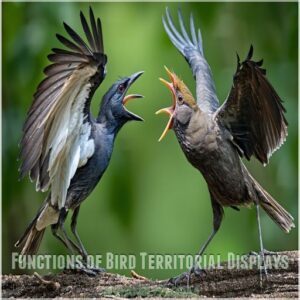This site is supported by our readers. We may earn a commission, at no cost to you, if you purchase through links.

These displays aren’t just about showing off—they’re strategic maneuvers to secure prime breeding sites, attract mates, and warn off competitors.
Whether you’re a songbird belting out a warning tune or a raptor puffing up your feathers, you’re communicating complex messages about ownership and boundaries.
From defending your nest to establishing social hierarchies, these displays are nature’s way of managing limited resources. Think of it as the avian version of prime real estate—location, location, location!
Table Of Contents
- Key Takeaways
- Why Birds Use Territorial Displays
- Types of Bird Territorial Displays
- Bird Territorial Behavior and Mating Systems
- How Birds Establish and Maintain Territories
- Characteristics of Bird Territorial Displays
- Functions of Bird Territorial Displays
- Bird Territorial Displays in Different Habitats
- Bird Territorial Displays and Human Impact
- Territorial Displays in Different Bird Species
- The Importance of Bird Terr
- Frequently Asked Questions (FAQs)
- What does it mean if a bird defends a ‘territory’?
- What is a defensive display of a bird?
- Why do some species make territorial displays?
- How do birds show off their territories?
- What is the definition of a bird’s territory?
- How does territoriality protect a bird?
- What does it mean when a bird displays?
- What birds are extremely territorial?
- What to do about a territorial bird?
- What are the birds courtship displays?
- Conclusion
Key Takeaways
- You’ll see how territorial displays aren’t just random behaviors, but strategic survival mechanisms that help birds secure critical resources like food, breeding sites, and protection from predators.
- You’ll discover that birds communicate their territorial boundaries through complex methods including vocal calls, visual postures, physical confrontations, and even subtle chemical signals that reveal their identity and fitness.
- You’ll recognize that territorial displays vary dramatically across species, with each bird adapting its approach to specific habitats—from dense forests to grasslands and shorelines—showcasing nature’s incredible diversity of survival strategies.
- You’ll understand that human activities like habitat fragmentation, noise pollution, and light pollution are forcing birds to continuously adapt their territorial behaviors, making conservation efforts crucial for maintaining these intricate ecological communication systems.
Why Birds Use Territorial Displays
You’ve probably watched birds defend their turf and wondered why they’re so aggressive about their territory.
Territorial displays help birds secure breeding sites, attract mates, and warn off potential predators.
By communicating critical survival information through complex visual and vocal signals.
To Establish Breeding Sites
In the high-stakes world of bird breeding, establishing the perfect nest site is like winning prime real estate.
Birds fiercely defend their territory, carefully selecting breeding grounds that offer maximum protection and resources.
Competition for ideal nesting sites drives territorial displays, with birds strategically choosing locations that minimize predator risk and maximize offspring survival chances.
To Attract and Keep Mates
Because finding the right mate is essential, birds pull out all the stops with jaw-dropping courtship displays.
Birds like the Albatrosses utilize strutting, bowing, and elaborate bonding displays.
Food offerings, synchronized movements, and eye-catching aerial displays communicate everything a potential mate needs to know about partner quality.
To Warn Off Predators
Birds ramp up their predator deterrence strategies when survival’s on the line.
Their aggressive body language speaks volumes – puffed feathers, wing-spreading, and sharp alarm calls turn would-be attackers away.
Through mobbing behavior and strategic distraction displays, they transform from potential prey into fierce defenders.
Nature’s warning system kicks into high gear, protecting vulnerable nests and young with calculated bird territorial defense.
Types of Bird Territorial Displays
You’ll encounter four primary types of bird territorial displays that showcase nature’s intricate communication strategies: vocal calls, visual postures, physical confrontations, and subtle chemical signals.
Each display represents a sophisticated survival technique.
These techniques help birds protect their resources, attract mates, and navigate the complex social landscapes of their ecosystems.
Vocal Displays Like Songs and Calls
Ever wondered how birds mark their turf without fences? Their vocal territorial calls are nature’s megaphones, broadcasting ownership across landscapes. These sound-based displays scream "This space is mine!" through complex song patterns and strategic call variations.
Territorial song powerhouses include:
- Heart-pounding alarm calls that freeze predators
- Intricate melodies warning rival species
- Duet performances showcasing partnership
- Rhythmic chirps mapping invisible boundaries
- Ear-splitting declarations of dominance
These calls serve many purposes beyond simple territorial marking. Birds use a variety of vocalizations to communicate effectively. Complex song patterns and variations are key to their success.
Visual Displays Like Courtship and Agonistic Behaviors
After their melodic calls fade, birds switch gears to visual storytelling.
Their plumage significance speaks volumes through intricate dance routines and color patterns.
Threat postures reveal complex bird aggression displays, while interspecies displays showcase nature’s elaborate communication.
Courtship behaviors transform territorial encounters into stunning performances of survival and attraction, where every feather and movement tells a strategic tale.
Physical Displays Like Chasing and Fighting
Building on courtship displays, birds kick territorial defense into high gear through physical confrontations that pack a serious punch. These fighting styles reveal nature’s raw survival strategies, where aggression becomes a critical communication tool.
Bird territorial fights showcase remarkable defense tactics and dominance displays.
- Chasing rivals reveals complex territorial boundaries
- Physical combat minimizes potential injury risks
- Aggressive displays communicate social hierarchies
- Success rates depend on strategic positioning
Chemical Displays Like Scent Marking
From fierce wing-flapping to strategic positioning, bird territorial displays now reveal a hidden world of scent communication.
Scientists have uncovered that birds use chemical signals to mark territories, with specialized scent glands playing a subtle yet powerful role in avian territoriality.
These olfactory messages help birds navigate complex social interactions, challenging previous beliefs about their communication methods.
Bird Territorial Behavior and Mating Systems
You’ll discover that bird territorial behavior isn’t just about turf wars, but a complex system where survival, mating, and resource protection intertwine.
These intricate displays reveal nature’s strategic dance of courtship, where every chirp, chase, and posture tells a story of adaptation and reproductive success.
Monogamous Pairs and Territorial Defense
When visual displays wrap up, monogamous bird pairs kick territorial defense into high gear.
They’ll protect their turf like seasoned warriors, coordinating nest defense through pair bonding and resource sharing.
Their synchronized efforts showcase mate fidelity, with both partners actively guarding breeding territories and repelling potential threats to safeguard their survival and protect their young.
Polygyny and Territorial Expansion
In bird breeding, some males break monogamy’s rules.
Polygynous birds expand territories to maximize resource competition and male fitness.
By controlling larger areas with prime nesting sites, these males increase their breeding success.
Females strategically choose territories that offer the best protection, food resources, and genetic advantages for their offspring.
Lek Mating and Territorial Displays
Lek mating’s spectacular bird-dance transforms territorial displays into nature’s most dramatic courtship arena. These competitive performance stages showcase males’ evolutionary prowess through complex rituals designed to attract discerning females.
In fact, birds also utilize chemical signals, such as uropygial secretions, to convey information about their identity and quality.
- Males cluster in designated display sites
- Elaborate plumage and choreographed movements dominate interactions
Female choice drives intense selective pressures. Territorial boundaries shift with display quality. Competition for genetic legacy.
Solitary Species and Territorial Marking
After the flamboyant displays of lek mating, some bird species march to a different drum.
Solitary birds rely on subtle territorial markers, using visual cues and strategic habitat use to claim their space.
Scent marking and strategic resource defense become their silent weapons, proving that not all bird territorial displays need to be loud or flashy.
How Birds Establish and Maintain Territories
You’ll discover that birds aren’t just chirping neighbors, but strategic land-grabbers who fight fiercely to claim prime real estate in nature’s competitive housing market.
When you understand their territorial tactics, you’ll see how these feathered warriors use vocalizations, visual displays, and aggressive behaviors to establish and maintain their vital living spaces.
Natal Dispersal and Territory Inheritance
When birds leave the nest, they’re playing a high-stakes game of sibling rivalry and survival. Their dispersal timing can make or break their territorial future.
Here’s how young birds navigate this challenge:
- Assess habitat quality
- Evaluate inherited territory potential
- Measure genetic fitness consequences
- Negotiate family boundaries
- Minimize competition with siblings
Inheritance isn’t just about land—it’s a strategic life blueprint for territorial success. Sibling rivalry and dispersal timing are key factors.
Floater Strategy and Territory Acquisition
Those pesky floaters in the bird world aren’t just hanging around – they’re strategic survivors waiting to swoop into prime territories.
These nomadic birds constantly scout for available territories, calculating their chances based on habitat suitability and competition displays.
Their survival strategy hinges on patience, keen observation, and lightning-fast territory acquisition when opportunity strikes.
Vagrant Settling and Territory Establishment
Imagine you’re a young bird seeking your first home—vagrant settling challenges even the most resilient explorers.
Traversing unfamiliar territories requires keen observation of habitat suitability and clever territory marking techniques.
Minimizing confrontations with established residents while securing a foothold in the avian landscapes, where survival rates depend on strategic dispersal patterns.
Habitat Selection and Territory Quality
After scouting vagrant territories, birds zero in on prime real estate that’ll support their survival.
Territory quality hinges on three key factors:
- Resource abundance (food, water, nesting materials)
- Predator protection and cover
- Proximity to breeding and foraging zones
Smart birds assess habitat availability like seasoned real estate agents, prioritizing spaces that maximize their chances of survival and reproductive success.
Characteristics of Bird Territorial Displays
You’ll discover that bird territorial displays are complex, nuanced behaviors unique to each species and individual bird.
When you observe these displays, you’ll notice they’re highly context-dependent, reflecting intricate communication strategies that have evolved over millions of years.
Species-Specific Displays and Behaviors
When establishing territories, birds aren’t one-size-fits-all warriors. Each species crafts unique displays that are nature’s signature communication system.
These species-specific behaviors reveal intricate strategies for survival and reproduction. Their threat postures and courtship rituals are evolutionary masterpieces, finely tuned to their ecological niche and survival needs.
| Bird Species | Unique Display |
|---|---|
| Red-winged Blackbird | Bright red wing patches |
| Northern Cardinal | Aggressive head-bobbing |
| Hummingbird | Aerial dance battles |
Unique displays, species-specific behaviors, and ecological niche are all key factors in bird territoriality.
Context-Dependent Displays and Behaviors
Because environmental factors shape bird territorial displays, their intensity varies dramatically with breeding stage and social context.
Threat levels dictate whether a bird will puff up dramatically or simply chirp a warning.
Depending on the situation, avian territorial displays can range from subtle posture shifts to full-blown aggressive confrontations, revealing the nuanced communication strategies of our feathered friends.
Individual Variation in Displays and Behaviors
Building on context-dependent behaviors, bird territorial displays reveal fascinating individual differences.
Genetic foundations shape unique display patterns across bird species, with age, hormones, and social learning influencing each bird’s approach.
Your backyard robin might defend territory differently from its neighbor, showcasing how experience and individual traits craft distinct avian territorial displays.
Development and Learning of Displays and Behaviors
Since birds don’t simply inherit territorial displays by magic, they develop these behaviors through a complex mix of genetic predisposition and social learning.
Their display behaviors evolve through fascinating developmental stages that shape their communication strategies.
- Genetic blueprints whisper survival secrets
- Social interactions craft behavioral masterpieces
- Experience transforms instinctual impulses
- Mentorship bridges innate and learned wisdom
Watch young birds carefully—they’re not just mimicking, they’re mastering the art of survival.
Functions of Bird Territorial Displays
You’ll discover that bird territorial displays aren’t just random squawks and feather ruffling, but complex communication strategies essential for survival.
These intricate behaviors help birds defend resources, attract mates, warn off predators, and establish social hierarchies in nature’s competitive landscape.
Resource Defense and Protection
Every bird knows the golden rule of survival: protect what’s yours.
Resource defense drives territorial behavior.
Birds fiercely guard food sources, water access, and prime nesting sites.
From hummingbirds battling over nectar feeders to woodpeckers defending tree cavities, these feathered fighters use songs, displays, and aggressive chases to maintain their hard-won territories.
Mate Attraction and Retention
Territorial displays are a bird’s ultimate dating profile.
By showcasing impressive plumage and defending prime real estate, birds signal genetic quality to potential mates.
Larger territories and flashy courtship rituals boost mate attraction, reducing divorce rates and increasing the likelihood of successful pair bonding.
A bird’s territory is its love nest, speaking volumes about its desirability.
Predator Deterrence and Warning
To protect their turf, birds use clever predator avoidance strategies.
Alarm calls warn others while mobbing behavior turns the tables, intimidating predators as a team.
Some species use feigning injury, drawing threats away from nests.
Aggressive displays, like puffed chests or sharp bird threat displays, signal danger to intruders.
These distraction displays safeguard their safety, blending instinct and survival.
Social Status and Dominance
As birds sort out predators, they also tussle for dominance. Displays reinforce social structure and bird dominance hierarchy, settling disputes and signaling status.
These displays help maintain order, reduce conflict, and clarify bird territorial ownership within social groups.
Here’s how:
- Colorful plumage signals status.
- Dramatic dances claim higher rank.
- Pecking order disputes resolve quickly.
- Songs reinforce dominance hierarchies.
Bird Territorial Displays in Different Habitats
You’ll notice that birds tailor their territorial displays to fit the unique challenges of their habitats, from dense forests to open grasslands and shorelines.
These behaviors safeguard their survival in their specific environments.
Whether it’s a hummingbird fiercely guarding a nectar source or a shorebird defending nesting space on a crowded beach, territorial displays are crucial.
Forest Birds and Territorial Displays
Forest birds rely on rich bird territorial calls and vibrant songs to claim their space amidst dense canopies.
Their territorial behavior often includes nesting defense and, occasionally, bird territorial fights.
Interspecies conflict flares up when resources grow scarce.
Habitat impact, like deforestation, reduces territory size, forcing unique adaptations in bird territorial displays to maintain boundaries and protect their nesting sites.
Grassland Birds and Territorial Displays
In grasslands, bird territorial behavior shines, with species like meadowlarks fiercely defending nest sites.
Bird territorial calls warn rivals, while territorial fights escalate over limited resources.
Grassland songbirds balance resource competition and territory size to secure prime spots.
Habitat impact, like farming, alters these delicate interactions, making bird territorial displays a key survival tool amidst species interactions and shifting environments.
Shorebirds and Territorial Displays
Shorebirds defend territories with bold moves and boundary alerts.
In marshes or mudflats, bird territorial signals include dramatic wing displays and sharp vocalizations, setting clear bird territorial boundaries.
Habitat impact can complicate bird competition displays, shrinking feeding zones. These variations influence breeding success and highlight conservation threats.
Shorebird territories reflect ingenious bird display behavior, balancing survival needs with intense rivalries in spaces they fiercely protect.
Hummingbirds and Territorial Displays
Hummingbirds turn territorial displays into high drama, especially when nectar-rich food sources are on the line. You’ll witness amazing acts of nectar defense and aggression.
Their colorful courtship rituals are all about impressing mates.
Fierce resource competition often drives them to defend nest sites.
Here’s what they’ll do:
- Chase rivals aggressively.
- Perform aerial acrobatics.
- Flash iridescent feathers.
- Vocalize sharp warning calls.
Bird Territorial Displays and Human Impact
You mightn’t realize it, but human activities like habitat destruction, noise, and light pollution are reshaping how birds defend their territories.
These changes disrupt their natural behaviors, forcing them to adapt or compete more aggressively for shrinking resources.
Habitat Fragmentation and Territory Reduction
When forests shrink or prairies vanish, territory reduction hits birds hard.
Habitat fragmentation forces species closer, sparking fights over resources. Higher population density and resource scarcity trigger bold behavioral changes in bird territorial behavior.
Conservation efforts aim to address species decline, but here’s the kicker: balancing population dynamics becomes tricky when habitat destruction outpaces recovery.
| Factor | Effect on Birds | Example Species | Conservation Need |
|---|---|---|---|
| Habitat destruction | Reduced territories | Woodpeckers | Reforestation |
| Increased population | Crowded nesting sites | Songbirds | Land preservation |
| Reduced breeding areas | Declining populations | Hummingbirds | Habitat corridors |
| Fragmentation | Disrupted communication | Grassland Sparrows | Noise pollution control |
Supplemental Feeding and Territory Expansion
Adding feeders boosts resource abundance, altering natural competition shifts among birds. This feeder effect often expands territory size as species guard the bonanza.
- Backyard feeders attract higher bird density.
- Feeding stations intensify territorial behavior.
- Species adapt bird territory marking near food sources.
- Aggression spikes to secure resource protection.
- Food resources change traditional territorial boundaries.
Noise Pollution and Territory Quality
Noise pollution messes with bird communication, disrupting songs essential for marking territories and attracting mates.
When territories overlap due to smaller sizes, the impact of noise pollution, competition soars, and it hurts breeding success.
This amplifies territorial behavior. For many bird species, the human impact creates conservation challenges, forcing adaptations to survive in a noisier world. It’s nature’s fight for balance.
Light Pollution and Territory Disruption
With the sprawling urban nightscape casting its glow, light pollution wreaks havoc on bird territorial behaviors and communication.
This disruptive force challenges their survival strategies through:
- Nighttime navigation errors
- Disrupted breeding success
- Altered territorial boundaries
- Compromised species-specific communication
Birds struggle to maintain their delicate territorial ecosystems, as artificial illumination increasingly fragments their natural behavioral patterns and survival mechanisms. Artificial illumination impacts birds.
Territorial Displays in Different Bird Species
You’ll find that bird territorial displays are wildly diverse, with each species showcasing unique strategies to claim and defend their turf.
From the melodious songs of songbirds to the fierce aerial displays of raptors, you’ll discover how these feathered fighters use vocalizations, body language, and aggressive behaviors to navigate the complex world of avian territorial dynamics.
Songbirds and Territorial Displays
Step into songbird territorial displays, where tiny feathered warriors defend their turf with incredible passion.
Mating songs and complex vocalizations become weapons in their battle for survival, marking territorial boundaries with precision.
These strategies, including the use of song learning, help ward off competitors, showcase fitness, and secure prime habitat for breeding and survival.
Birds of Prey and Territorial Displays
After exploring songbirds’ territorial tactics, we’ll zoom in on birds of prey‘s high-stakes territorial displays.
Hawks and eagles use dramatic aerial maneuvers to establish territorial boundaries, showcasing impressive hunting strategies and nest defense mechanisms.
Their territorial behavior reveals complex dominance displays, where wing-span, aerial agility, and aggressive posturing determine who rules the sky’s hunting grounds. territorial behavior reveals dominance displays.
Waterbirds and Territorial Displays
How do waterbirds stake their claim in nature’s high-stakes territorial drama?
Waterbird territory maps offer insight into their strategies.
These masters of coastal defense transform their habitats into fiercely protected domains through intricate displays:
- Elaborate wing-spreading territorial marking
- Synchronized colony defense strategies
- Complex diving displays of dominance
- Strategic resource competition behaviors
Waterbird territory size dictates survival, with breeding colonies becoming battlegrounds of intricate communication and spatial negotiation.
The Importance of Bird Terr
Understanding territorial benefits goes beyond simple bird squabbles. Territorial behavior acts as nature’s population control mechanism, directly influencing survival rates and resource access. It’s a strategy that guarantees species thrive a 3-5 word contextual phrase.
Here’s a quick breakdown of territorial impacts:
| Aspect | Short-term Effect | Long-term Consequence |
|---|---|---|
| Resource Defense | Immediate food security | Species population stability |
| Mating Displays | Attract potential partners | Genetic diversity preservation |
| Spatial Behavior | Limit competition | Ecosystem balance |
Bird dominance displays aren’t just drama – they’re a survival strategy in feathered form.
Frequently Asked Questions (FAQs)
What does it mean if a bird defends a ‘territory’?
You might think bird territories are just random squabbles, but they’re strategic survival zones.
Birds fiercely defend specific areas to secure food, shelter, and breeding rights, ensuring their offspring’s best chance at survival.
What is a defensive display of a bird?
When threatened, birds puff up feathers, spread wings, or bob their heads to look larger and more intimidating.
These dramatic postures warn rivals and predators to back off, signaling the bird’s readiness to defend itself.
Why do some species make territorial displays?
Birds make territorial displays to secure essential resources like food, nesting sites, and breeding grounds.
These displays communicate ownership through aggressive postures, vocalizations, and physical actions.
Such actions deter potential competitors and protect their survival.
How do birds show off their territories?
You’ll stake your claim through loud songs, dramatic displays, and fierce boundary patrols.
Puffed feathers, wing-flashing, and aggressive chasing warn intruders.
They’ve crossed a line in your hard-earned avian territory.
What is the definition of a bird’s territory?
Like a fortress guarding precious resources, a bird’s territory is the exclusive area it defends against competitors.
It uses vocalizations, displays, and aggressive behaviors to secure critical breeding, feeding, and nesting spaces.
How does territoriality protect a bird?
Territoriality safeguards birds by securing essential resources like food, nesting sites, and breeding grounds.
It prevents competition, reduces predation risks, and guarantees survival.
Strategic defense of prime locations is critical for reproduction and offspring protection.
What does it mean when a bird displays?
Ever watched a bird’s silent stage performance?
When a bird displays, it’s communicating complex messages through body language.
Showing dominance, defending territory, attracting mates, or warning off potential threats with strategic movements and postures.
What birds are extremely territorial?
You’ll find Northern Mockingbirds, Red-winged Blackbirds, and Hummingbirds top the territorial charts.
They’ll fiercely defend feeding zones, nesting sites, and breeding territories.
with aggressive displays that’ll make other birds think twice.
What to do about a territorial bird?
When these feathered fighters ruffle your feathers, stay calm and give them space.
Minimize threats by avoiding nesting areas, using visual barriers, and removing potential food sources that attract territorial birds.
What are the birds courtship displays?
Courting birds dazzle potential mates through vibrant plumage displays.
Intricate dance-like movements are also used.
Elaborate songs showcase their fitness, health, and genetic prowess.
This is a mesmerizing biological performance of attraction and selection.
Conclusion
Ultimately, bird territorial displays are a high-stakes survival strategy straight out of a prehistoric playbook.
You’ll witness these complex behaviors revealing nature’s intricate social dynamics.
Bird territorial displays aren’t just about aggression—they’re sophisticated communication systems that determine breeding success, resource access, and species survival.
By understanding these remarkable behaviors, you’ll gain insights into how birds navigate their challenging environments, ensuring their genetic legacy through strategic territorial management.
- https://birdfact.com/bird-behavior/social-structures/territorial-behavior
- https://www.allaboutbirds.org/news/there-goes-the-neighborhood-territoriality-in-bird-communities/
- https://www.birdlife.org/news/2022/02/03/this-is-how-you-court-according-to-birds/
- https://pmc.ncbi.nlm.nih.gov/articles/PMC2507733/
- https://nestwatch.org/learn/general-bird-nest-info/nesting-cycle/


















